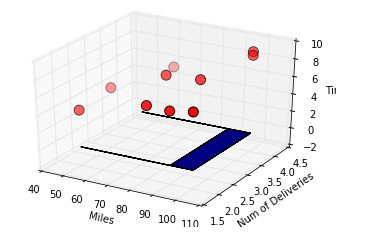目录
多元线性回归
当Y值的影响因素不是唯一时,采用多元线性回归
![]()
参数:![]()
代价函数:
梯度下降法:![]()
更新参数:
梯度下降法实现
- 首先把需要用到的库导入
import numpy as np
from numpy import genfromtxt
import matplotlib.pyplot as plt
from mpl_toolkits.mplot3d import Axes3D
%matplotlib inline- 载入数据
#载入数据
data = np.genfromtxt("Delivery.csv",delimiter=",")
print(data)
x_data = data[:,:-1] #取全部行,不包含最后一列的数据
y_data = data[:,-1] #取最后一列中所有行的数据
print(x_data)
print(y_data)载入的数据打印如第一张图,经过数据处理,打印如第二张图:


- 接下来实现最小二乘法函数以及梯度下降法的函数,更新回归线的参数,使误差更小(这里最小二乘法以及梯度下降法与一元线性回归用到的方法一样)
#学习率
lr = 0.0001
#参数
theta0 = 0
theta1 = 0
theta2 = 0
#迭代次数
epochs = 1000
#最小二乘法
def minimum_squares(x_data,y_data,theta0,theta1,theta2):
totalError =0
for i in range(0,len(x_data)):
totalError += (y_data[i] -(x_data[i,0]*theta1 + x_data[i,1]*theta2 + theta0)) **2
return totalError / float(len(x_data))
def gradient_descent_runner(x_data,y_data,theta0,theta1,theta2,lr,epochs):
#计算总数据量
m = float(len(x_data))
#循环epochs次
for i in range (epochs):
#设置临时量
theta0_grad = 0
theta1_grad = 0
theta2_grad = 0
#计算梯度总合再求平均
for j in range (0,len(x_data)):
theta0_grad += (1/m) *((x_data[j,0]*theta1 + x_data[j,1]*theta2 +theta0) - y_data[j])
theta1_grad += (1/m) *((x_data[j,0]*theta1 + x_data[j,1]*theta2 +theta1) - y_data[j]) * x_data[j,0]
theta2_grad += (1/m) *((x_data[j,0]*theta1 + x_data[j,1]*theta2 +theta2) - y_data[j]) * x_data[j,1]
#更新theta0,theta1,theta2的值
theta0 = theta0 - (lr*theta0_grad)
theta1 = theta1 - (lr*theta1_grad)
theta2 = theta2 - (lr*theta2_grad)
return theta0,theta1,theta2- 最后打印出结果:
print("Staring theta0 = {0},theta1 = {1},theta2 = {2},error = {3}".
format(theta0,theta1,theta2,minimum_squares(x_data,y_data,theta0,theta1,theta2)))
print("Running.......")
theta0,theta1,theta2 = gradient_descent_runner(x_data,y_data,theta0,theta1,theta2,lr,epochs)
print("After {0} iterations theta0 = {1},theta1 = {2},theta2 = {3},error = {4}".
format(epochs,theta0,theta1,theta2,minimum_squares(x_data,y_data,theta0,theta1,theta2))) 
上图是打印出来的结果,可以看出,在没有进行梯度下降前,我们得到的误差为47.27,经过梯度下降后,我们的误差减小到了0.7648
最后我们可以画出这个模型的图,来真实感受一下
ax = plt.figure().add_subplot(111,projection = '3d')
ax.scatter(x_data[:,0],x_data[:,1],y_data,c = 'r',marker = 'o',s = 100)
x0 = x_data[:,0]
x1 = x_data[:,1]
#生成网格矩阵
x0,x1 = np.meshgrid(x0,x1)
z = theta0 + theta1*x0 + theta2*x1
#画3D图
ax.plot_surface(x0,x1,z)
#设置坐标轴
ax.set_xlabel('Miles')
ax.set_ylabel('Num of Deliveries')
ax.set_zlabel('Time')
#显示图像
plt.show()

静态的图,我们看到的并不是很清楚,但是在运行中可以将次图显示成动态的图,就可以很清楚的看到两张图误差的大小。
我用到的是jupyter,在编辑完成代码后,使用如下操作,将代码下载成python格式,然后在命令提示符中运行次代码,就可以生成动态的图。(注意在命令提示符运行中,先要将路径切换到代码存放的路径上)

sklearn ---多元线性回归
其实,我们要实现多元线性回归,我们也可以直接调用库来完成,代码如下(接下来就不做解释)
from sklearn import linear_model
import numpy as np
import matplotlib.pyplot as plt
from mpl_toolkits.mplot3d import Axes3D
%matplotlib inline
#载入数据
data = np.genfromtxt("Delivery.csv",delimiter=",")
print(data)
x_data = data[:,:-1]
y_data = data[:,-1]
print(x_data)
print(y_data)
model =linear_model.LinearRegression()
model.fit(x_data,y_data)
#系数
print("coefficients:",model.coef_)
#截距
print("intercept:",model.intercept_)
#测试
x_test = [[102,4]]
predict = model.predict(x_test)
print("predict:",predict)
ax = plt.figure().add_subplot(111,projection = '3d')
ax.scatter(x_data[:,0],x_data[:,1],y_data,c = 'r',marker = 'o',s = 100)
x0 = x_data[:,0]
x1 = x_data[:,1]
#生成网格矩阵
x0,x1 = np.meshgrid(x0,x1)
z = model.intercept_ + model.coef_[0] *x0 + model.coef_[1] *x1
#画3D图
ax.plot_surface(x0,x1,z)
#设置坐标轴
ax.set_xlabel('Miles')
ax.set_ylabel('Num of Deliveries')
ax.set_zlabel('Time')
#显示图像
plt.show()结果如图:
























 463
463











 被折叠的 条评论
为什么被折叠?
被折叠的 条评论
为什么被折叠?








